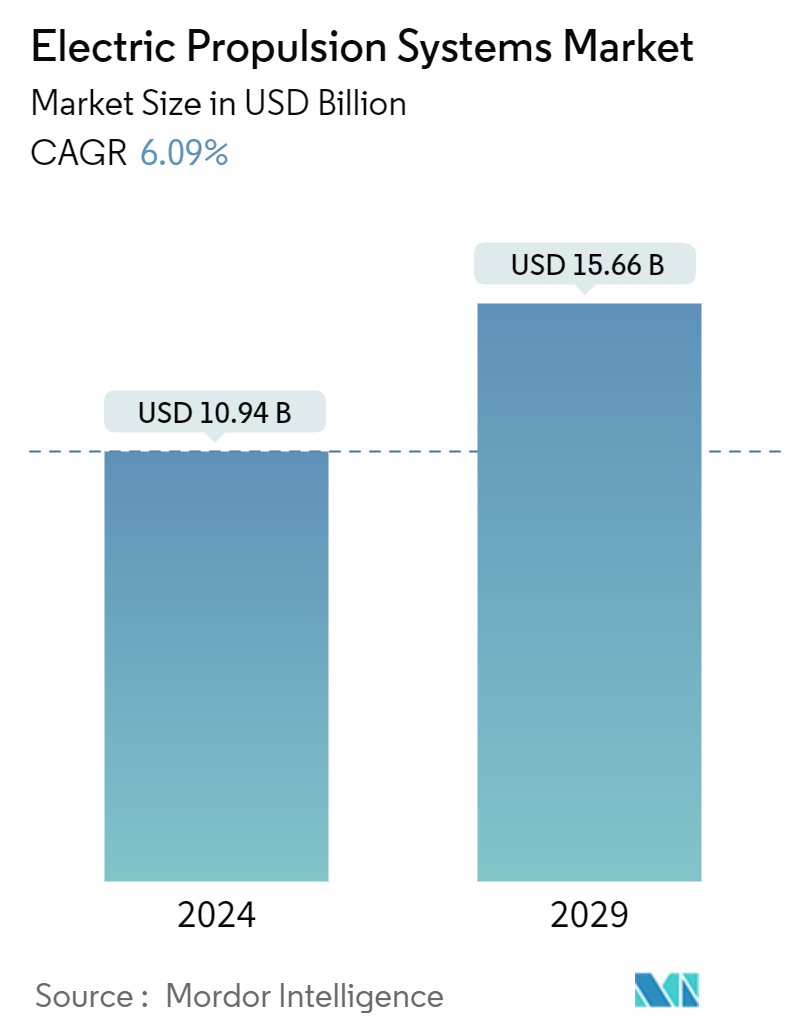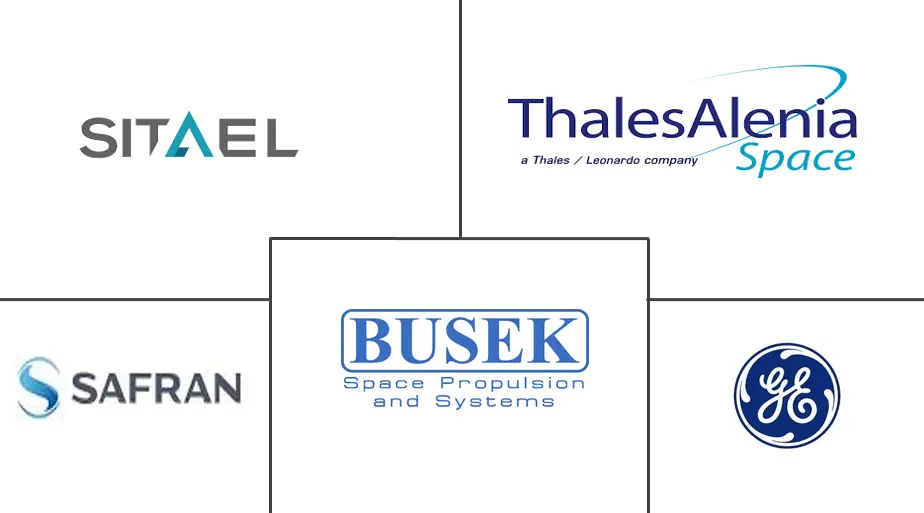Market Size of Electric Propulsion Systems Industry

| Study Period | 2019 - 2029 |
| Market Size (2024) | USD 10.94 Billion |
| Market Size (2029) | USD 15.66 Billion |
| CAGR (2024 - 2029) | 6.09 % |
| Fastest Growing Market | Europe |
| Largest Market | North America |
Major Players
*Disclaimer: Major Players sorted in no particular order |
Electric Propulsion Systems Market Analysis
The Electric Propulsion Systems Market size is estimated at USD 10.94 billion in 2024, and is expected to reach USD 15.66 billion by 2029, growing at a CAGR of 6.09% during the forecast period (2024-2029).
Space-based activities have flourished during the last decade, as evidenced by the number of satellites launched for commercial and defense applications, ranging from telecommunication and earth observation to experimental scientific research. The absence of a combustion-supporting atmosphere in space has resulted in the increased adoption of electric propulsion technologies for maneuvering satellites in orbit.
Given the spike in related development activities in the aviation sector, corporates and investors appear keen to integrate electrical propulsion systems and capitalize on the shift towards a sustainable aviation market. All-electric and hybrid-electric drive systems allow aircraft to fly with power from renewable resources or fuel cells instead of fossil fuels, making new aircraft designs possible. Besides, the emergence of global green emission initiatives has encouraged the adoption of eco-friendly propulsion technologies, such as electric propulsion.
Electric Propulsion Systems Industry Segmentation
Electric propulsion is a technology aimed at achieving thrust with high exhaust velocities, which reduces the amount of propellant required for a given space mission or application compared to other conventional propulsion methods. It encompasses any propulsion technology that uses electricity to increase the propellant exhaust velocity.
The electric propulsion systems market is segmented by type, application, and geography. Based on type, the market is segmented into hybrid and full-electric systems. The market based on application is further segmented into airborne, terrestrial, marine, and space-based and is analyzed in the study's purview. The report also covers the market sizes and forecasts for the electric propulsion systems market in major countries across different regions. For each segment, the market size is provided in terms of value (USD).
| By Type | |
| Hybrid | |
| Full-electric |
| By Application | |
| Airborne | |
| Terrestrial | |
| Marine | |
| Space |
| Geography | |||||||
| |||||||
| |||||||
| |||||||
| |||||||
|
Electric Propulsion Systems Market Size Summary
The electric propulsion systems market is poised for significant growth, driven by the increasing demand for sustainable and eco-friendly technologies across various sectors. The aerospace industry, in particular, is witnessing a surge in the adoption of electric propulsion systems due to the need for reducing greenhouse gas emissions and enhancing fuel efficiency. The shift towards electric and hybrid-electric drive systems in aviation is facilitated by advancements in renewable energy sources and fuel cell technologies, enabling new aircraft designs that are less reliant on fossil fuels. This transition is further supported by global green emission initiatives, which are encouraging the development and integration of electric propulsion technologies in both commercial and military aircraft. The market is characterized by strategic collaborations and ongoing development activities, with key players like SITAEL SpA., Busek Co. Inc., General Electric Company, Thales Alenia Space, and Safran SA leading the charge in designing and manufacturing complete electric propulsion systems.
In the space sector, the increasing number of satellites launched for various applications, including telecommunications and earth observation, has spurred the adoption of electric propulsion technologies for orbital maneuvers. The absence of a combustion-supporting atmosphere in space makes electric propulsion systems a viable solution for satellite maneuvering. The advent of miniaturized electronics and smart manufacturing materials has also contributed to the development of small satellites, which require powerful yet compatible electric propulsion systems for effective orbital correction. The maritime sector in Europe is also experiencing a push towards sustainability, with significant measures being taken to reduce environmental impacts. This trend is expected to drive the demand for electric propulsion systems across all platforms, enhancing the market's growth prospects. The market remains highly competitive and fragmented, with long-term collaborations and extensive R&D being crucial for gaining a competitive edge and developing sophisticated systems.
Electric Propulsion Systems Market Size - Table of Contents
-
1. MARKET DYNAMICS
-
1.1 Market Overview
-
1.2 Market Drivers
-
1.3 Market Restraints
-
1.4 Porter's Five Forces Analysis
-
1.4.1 Bargaining Power of Suppliers
-
1.4.2 Bargaining Power of Buyers/Consumers
-
1.4.3 Threat of New Entrants
-
1.4.4 Threat of Substitute Products
-
1.4.5 Intensity of Competitive Rivalry
-
-
-
2. MARKET SEGMENTATION
-
2.1 By Type
-
2.1.1 Hybrid
-
2.1.2 Full-electric
-
-
2.2 By Application
-
2.2.1 Airborne
-
2.2.2 Terrestrial
-
2.2.3 Marine
-
2.2.4 Space
-
-
2.3 Geography
-
2.3.1 North America
-
2.3.1.1 United States
-
2.3.1.2 Canada
-
-
2.3.2 Europe
-
2.3.2.1 United Kingdom
-
2.3.2.2 France
-
2.3.2.3 Germany
-
2.3.2.4 Italy
-
2.3.2.5 Rest of Europe
-
-
2.3.3 Asia-Pacific
-
2.3.3.1 China
-
2.3.3.2 India
-
2.3.3.3 South Korea
-
2.3.3.4 Japan
-
2.3.3.5 Rest of Asia-Pacific
-
-
2.3.4 Latin America
-
2.3.4.1 Brazil
-
2.3.4.2 Mexico
-
2.3.4.3 Rest of Latin America
-
-
2.3.5 Middle East and Africa
-
2.3.5.1 Saudi Arabia
-
2.3.5.2 United Arab Emirates
-
2.3.5.3 Saudi Arabia
-
2.3.5.4 Rest of Middle East and Africa
-
-
-
Electric Propulsion Systems Market Size FAQs
How big is the Electric Propulsion Systems Market?
The Electric Propulsion Systems Market size is expected to reach USD 10.94 billion in 2024 and grow at a CAGR of 6.09% to reach USD 15.66 billion by 2029.
What is the current Electric Propulsion Systems Market size?
In 2024, the Electric Propulsion Systems Market size is expected to reach USD 10.94 billion.

